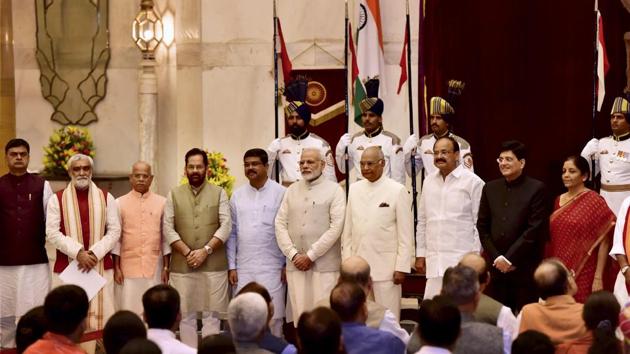A message in cabinet reshuffle: PM Modi won’t shy away from testing strategies
Nirmala Sitharaman was appointed the defence minister and Piyush Goyal the railway minister as Prime Minister Narendra Modi revamped his team on Sunday.
If performance was the criterion for promotion, demotion and resignation of ministers in the latest reshuffle and expansion of Prime Minister Narendra Modi’s team on Sunday, it also reflected his intent to try out new strategies to rev up governance. (Highlights)

Sunday’s exercise was predominantly an effort to bring renewed focus and energy into the government with barely 21 months ahead of the next general elections, but it was marked by political symbolism too. The appointment of Nirmala Sitharaman as defence minister is expected to go down well with women across the country.
The Rashtriya Swayamsevak Sangh hailed it as a “great and remarkable thing” that there will be two woman ministers — the first being external affairs minister Sushma Swaraj— in the cabinet committee on security that comprises the Prime Minister, the home minister and the finance minister as well.
The promotion of Sitharaman and Dharmendra Pradhan and induction of KJ Alphons in the government are expected to boost the BJP’s prospects in their home states — Tamil Nadu, Odisha and Kerala.
What marked the third rejig of Team Modi was the Prime Minister’s decisiveness and willingness to make experiments. He is known to spring surprises in picking his team and there were quite a few this weekend — giving independent charge of ministries to three former bureaucrats who joined the Union council for the first time, shifting Uma Bharti to a low-profile ministry, demoting Vijay Goel, bringing new faces in the infrastructure ministries such as railways, power, and housing and urban affairs, among others.
Modi didn’t shy away from showing the exit door to half-a-dozen non-performing ministers and cutting to size a few others such as Bharti and Goel. The message may not be lost on others who have managed to survive the latest rejig.
That Modi put a premium on performance while revamping his team was evident from promotion of ministers such as Piyush Goyal, Pradhan, Sitharaman and Mukhtar Abbas Naqvi to cabinet rank. Ministers of state such as Rajyavardhan Singh Rathore and Santosh Gangwar were given independent charge of ministries. All of them were known to be efficient.
Petroleum minister Pradhan was given the added responsibility of skill development, which has been a big disappointment so far. Goyal was tasked to turn around the railways at a time the ministry’s image suffered a battering from a spate of crashes and deaths.
Sitharaman’s choice as defence minister might be a surprise, but she has the proven ability to respond to new challenges, be it in her capacity as a BJP spokesperson in her initial years or as commerce minister in this government.
What left many perplexed was the Prime Minister’s decision to induct domain experts but give them responsibilities unrelated to their core areas of competence. Former diplomat Hardeep Singh Puri was made minister of housing and urban affairs, former home secretary RK Singh the power minister, Delhi “Demolition Man” KJ Alphons the minister of tourism, and former Mumbai police commissioner Satyapal Singh a junior minister of human resource development and water resources.
But the idea, say ruling party leaders, is to bring professional competence, efficiency, and more administrative experience into the government, regardless of their areas of expertise.
Modi might have played a gambit by bringing new faces in so many ministries because they might not have much time to settle in and turn things around ahead of 2019 general elections. But given that here is a pro-active prime minister’s office that guides and monitors the functioning of ministers, they might get going sooner than one expects.





